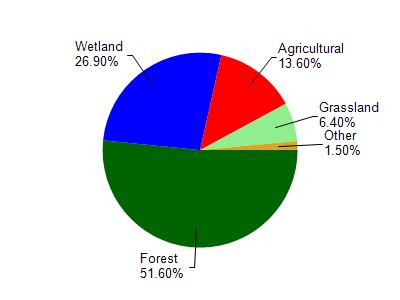Taylor
No
No
No
Fish and Aquatic Life
Overview
Wood Lake is a soft water, drainage lake located at the headwaters of Wood Creek. The normal outlet flow is estimated to be 0.7 cubic feet per second. Winterkill occurs occasionally. The fish population consists of largemouth bass and panfish. The shoreline vegetation is 52 percent upland hardwood, 25 percent swamp hardwood and 23 percent shrub-conifer swamp. The littoral bottom materials are 50 percent rubble area, 20 percent gravel, 15 percent boulder, 10 percent sand, and five percent muck shoreline. Aquatic vegetation is sparse. Muskrat use is not significant, but beaver are present. Waterfowl use is limited to a few puddle and diving ducks that use the lake during their spring and fall migrations. There is no public access. Private development is limited to one campground.
Source: 1970, Surface Water Resources of Taylor County Wood Lake, T33N, R3E, Section 23 Surface Acres = 62.5, Maximum Depth = 31 feet, M.P.A. = 21 ppm, Secchi Disk = 5 feet
Date 1970
Author Aquatic Biologist
General Condition
Wood Lake Beach was assessed for the 2018 listing cycle; E. coli data sample data were clearly below the 2018 WisCALM listing thresholds for the Recreation use. This beach was meeting this designated use and was not considered impaired.
Date 2017
Author Ashley Beranek
Condition
Wisconsin has over 84,000 miles of streams, 15,000 lakes and milllions of acres of wetlands. Assessing the condition of this vast amount of water is challenging. The state's water monitoring program uses a media-based, cross-program approach to analyze water condition. An updated monitoring strategy (2015-2020) is now available. Compliance with Clean Water Act fishable, swimmable standards are located in the Executive Summary of Water Condition in 2018. See also the 'monitoring and projects' tab.
Reports
Management Goals
Wisconsin's Water Quality Standards provide qualitative and quantitative goals for waters that are protective of Fishable, Swimmable conditions [Learn more]. Waters that do not meet water quality standards are considered impaired and restoration actions are planned and carried out until the water is once again fishable and swimmable
Management goals can include creation or implementation of a Total Maximum Daily Load analysis, a Nine Key Element Plan, or other restoration work, education and outreach and more. If specific recommendations exist for this water, they will be displayed below online.
Monitoring
Monitoring the condition of a river, stream, or lake includes gathering physical, chemical, biological, and habitat data. Comprehensive studies often gather all these parameters in great detail, while lighter assessment events will involve sampling physical, chemical and biological data such as macroinvertebrates. Aquatic macroinvertebrates and fish communities integrate watershed or catchment condition, providing great insight into overall ecosystem health. Chemical and habitat parameters tell researchers more about human induced problems including contaminated runoff, point source dischargers, or habitat issues that foster or limit the potential of aquatic communities to thrive in a given area. Wisconsin's Water Monitoring Strategy was recenty updated.
Grants and Management Projects
| Project Name (Click for Details) | Year Started |
|---|
|
|
Monitoring Projects
| WBIC | Official Waterbody Name | Station ID | Station Name | Earliest Fieldwork Date | Latest Fieldwork Date | View Station | View Data |
|---|
| 1467100 | Wood Lake | 10014703 | Wood Lake - Beach | 7/8/2003 | 7/26/2021 | Map | Data |
| 1467100 | Wood Lake | 10005825 | Wood Lake | 8/29/2000 | 8/6/2020 | Map | Data |
| 1467100 | Wood Lake | 10019257 | Wood Lake -- Access | 7/8/2015 | 7/8/2015 | Map | Data |
| 1467100 | Wood Lake | 613053 | Wood Lake - Deep Hole | 8/8/1979 | 8/20/2001 | Map | Data |
|

Watershed Characteristics
Wood Lake is located in the Upper Rib River watershed which is 197.07 mi². Land use in the watershed is primarily forest (51.60%), wetland (26.90%) and a mix of agricultural (13.60%) and other uses (7.90%). This watershed has stream miles, lake acres and 17,127.41 wetland acres.
Nonpoint Source Characteristics
This watershed is ranked Low for runoff impacts on streams, Low for runoff impacts on lakes and Low for runoff impacts on groundwater and therefore has an overall rank of Low. This value can be used in ranking the watershed or individual waterbodies for grant funding under state and county programs.However, all waters are affected by diffuse pollutant sources regardless of initial water quality. Applications for specific runoff projects under state or county grant programs may be pursued. For more information, go to surface water program grants.